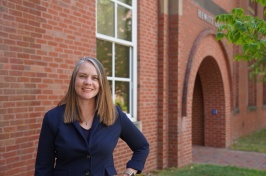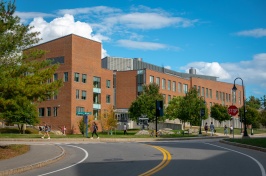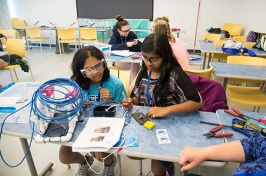Carsey Institute: Reading Levels of Rural and Urban Third-Graders Lag Behind Suburban Peers

Joshua Stawarz of Kittery, Maine, is the recipient of a National Science Foundation fellowship. Photo credit: Lisa Nugent, UNH Photographic Services.
DURHAM, N.H. - The reading levels of rural and urban third-graders lag behind the reading levels of their suburban peers, the consequences of which can have important effects on later educational outcomes, according to new research from the Carsey Institute at the University of New Hampshire.
"To some extent, the differences in average reading achievement for rural, urban, and suburban third-graders reflect average achievement differences at the start of kindergarten. In addition, the average reading gains from kindergarten through Grade 3 for rural and urban children are lower than the gains for suburban children," said Suzanne Graham, associate professor of education at UNH.
Conducted by Graham and Christine Teague, a doctoral student in the UNH Department of Education, the research relies on data from the Early Childhood Longitudinal Study, a multiyear study of a nationally representative sample of more than 22,000 children between 1998 and 2006. Children were surveyed two times during kindergarten, then in the spring of Grades 1, 3, 5, and 8. Teachers, parents, and school administrators also were surveyed. The data sample used for the brief consists of the 8,405 public school students for whom information was available on K-3 reading achievement, school location, family socioeconomic status, child race or ethnicity, and gender.
The key findings show:
- Rural and urban third-graders have lower average reading achievement levels than their suburban peers.
- Suburban children realize greater gains in reading achievement from kindergarten to third grade than their suburban or urban counterparts.
- Third-grade reading achievement gaps between rural, urban, and suburban children are associated with socioeconomic background differences.
- Rural students who were struggling readers at the beginning of kindergarten have lower average reading achievement in third grade than both urban and suburban students when children of the same socioeconomic status are compared.
- There are no average achievement differences by location for third-graders who were high achievers at the start of kindergarten.
- Only 27 percent of teachers in rural schools report active professional development programs in their schools, compared with 40 percent of teachers in suburban and urban schools.
"Reading achievement represents a complex interplay of family, school, and community factors. The differences in reading achievement at the start of kindergarten may reflect differences in preschool attendance among rural students. In addition, parents of rural children tend to have less education than urban and suburban parents," Graham said.
"The differences in third-grade reading achievement between rural and nonrural children who were low achievers in kindergarten most likely reflect different educational opportunities and school resources available to these children," she said.
The complete report about this research is available at http://carseyinstitute.unh.edu/CarseySearch/search.php?id=161.
The Carsey Institute at the University of New Hampshire conducts research and analysis on the challenges facing families and communities in New Hampshire, New England, and the nation. The Carsey Institute sponsors independent, interdisciplinary research that documents trends and conditions affecting families and communities, providing valuable information and analysis to policymakers, practitioners, the media, and the general public. Through this work, the Carsey Institute contributes to public dialogue on policies that encourage social mobility and sustain healthy, equitable communities.
The Carsey Institute was established in May 2002 through a generous gift from UNH alumna and noted television producer Marcy Carsey. For more information about the Carsey Institute, go to www.carseyinstitute.unh.edu.
The University of New Hampshire, founded in 1866, is a world-class public research university with the feel of a New England liberal arts college. A land, sea, and space-grant university, UNH is the state's flagship public institution, enrolling 12,200 undergraduate and 2,300 graduate students.
-30-
Latest News
-
October 8, 2025
-
October 2, 2025
-
September 24, 2025
-
September 15, 2025
-
August 21, 2025















































